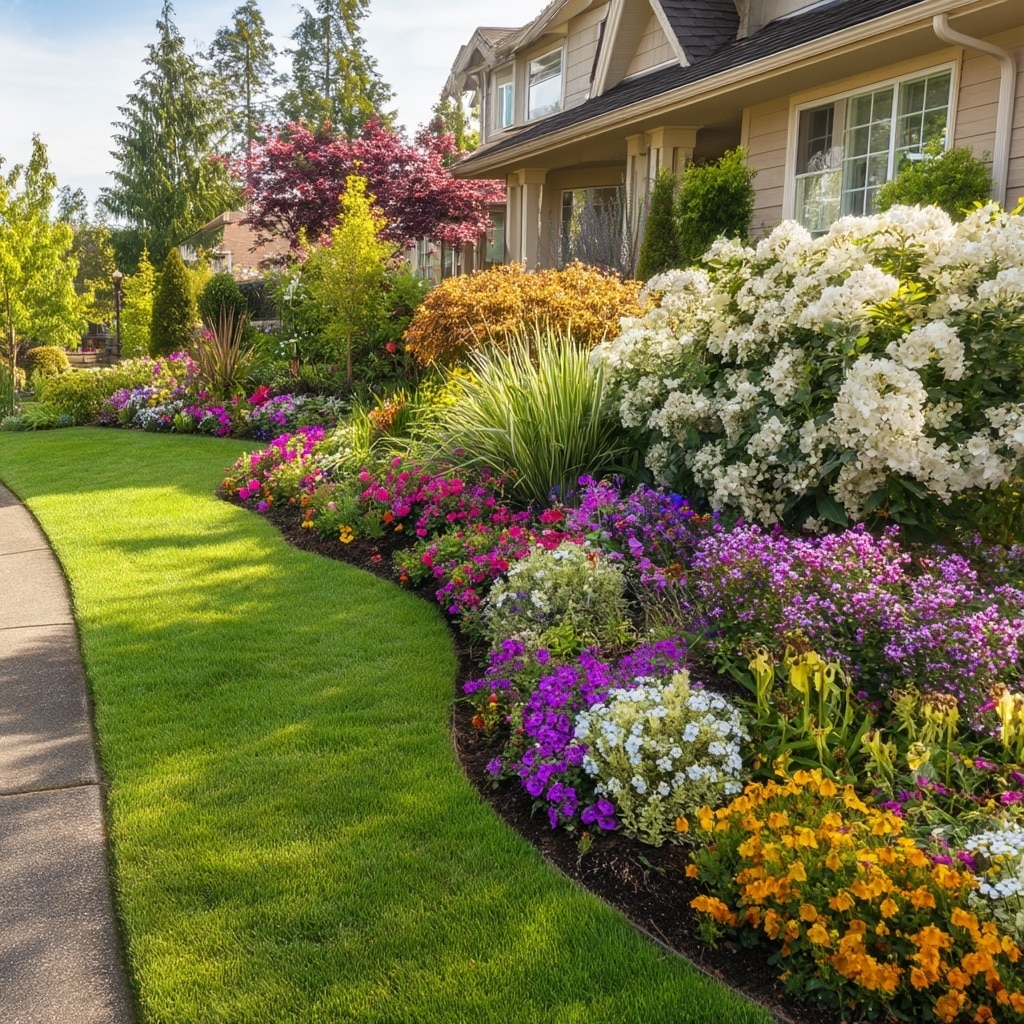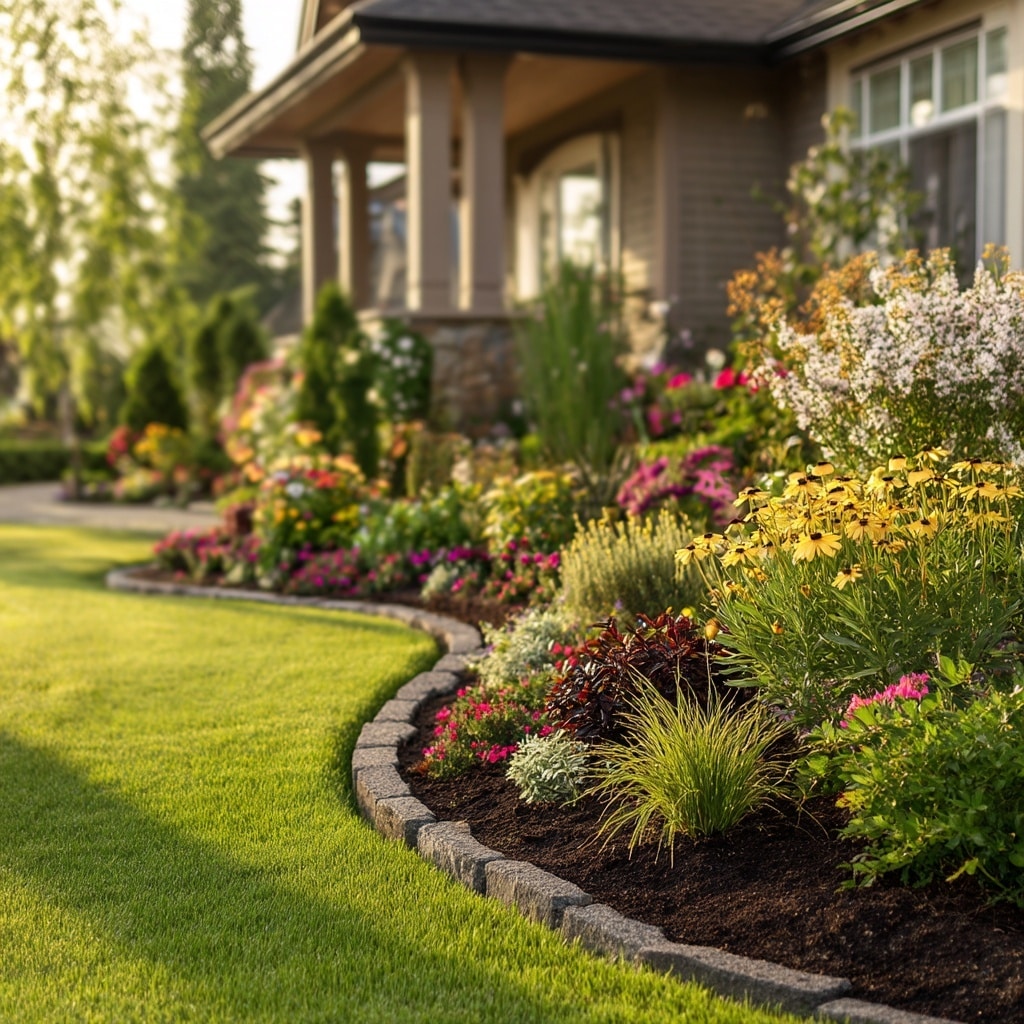Flower beds in front of house are more than just a landscaping choice—they’re a warm welcome to every visitor and a daily burst of beauty for you. Whether you’re working with a compact space or a sprawling lawn, the right design can boost curb appeal, express your style, and even raise your home’s value. With smart planning and the right plant combinations, you can transform your front yard into a living work of art that blooms across the seasons.
Table of Contents
Understanding the Basics of Flower Bed Design
Before planting your favorite blooms, it’s essential to get the foundation right. Designing flower beds in front of house means thinking beyond just color. The shape, size, soil, sunlight, and spacing all play a role in how your garden grows and looks through the seasons.
1. Shape and Layout Matter
Start by sketching the outline of your front yard. Do you want curved edges for a soft, organic feel? Or clean, straight lines for a more formal look? Popular shapes include:
- Rectangular beds – great for structured, symmetrical spaces
- Curved borders – soften the look of walkways and driveways
- Corner beds – make use of dead space and frame your home naturally
Soil Quality and Drainage
Healthy plants start with healthy soil. Test your soil’s pH and nutrient levels before planting. Amend with compost or organic matter to improve fertility. If water tends to pool in areas, consider raising the bed or adding proper drainage to avoid root rot.
3. Sunlight Exposure
Observe how much sun different parts of your front yard get throughout the day. Most flowering plants need at least 6 hours of sun, but some thrive in partial shade. Group plants by light needs to help them flourish side by side.
4. Balance and Height Variation
A well-designed bed uses plant height to create depth:
- Tall plants (like delphiniums or ornamental grasses) go in the back or center
- Medium-height flowers form the mid-layer
- Low-growing ground covers or border plants finish the front edge
This structure ensures every bloom is visible, and the overall composition looks full and intentional.
Choosing the Right Flowers for Your Front Yard
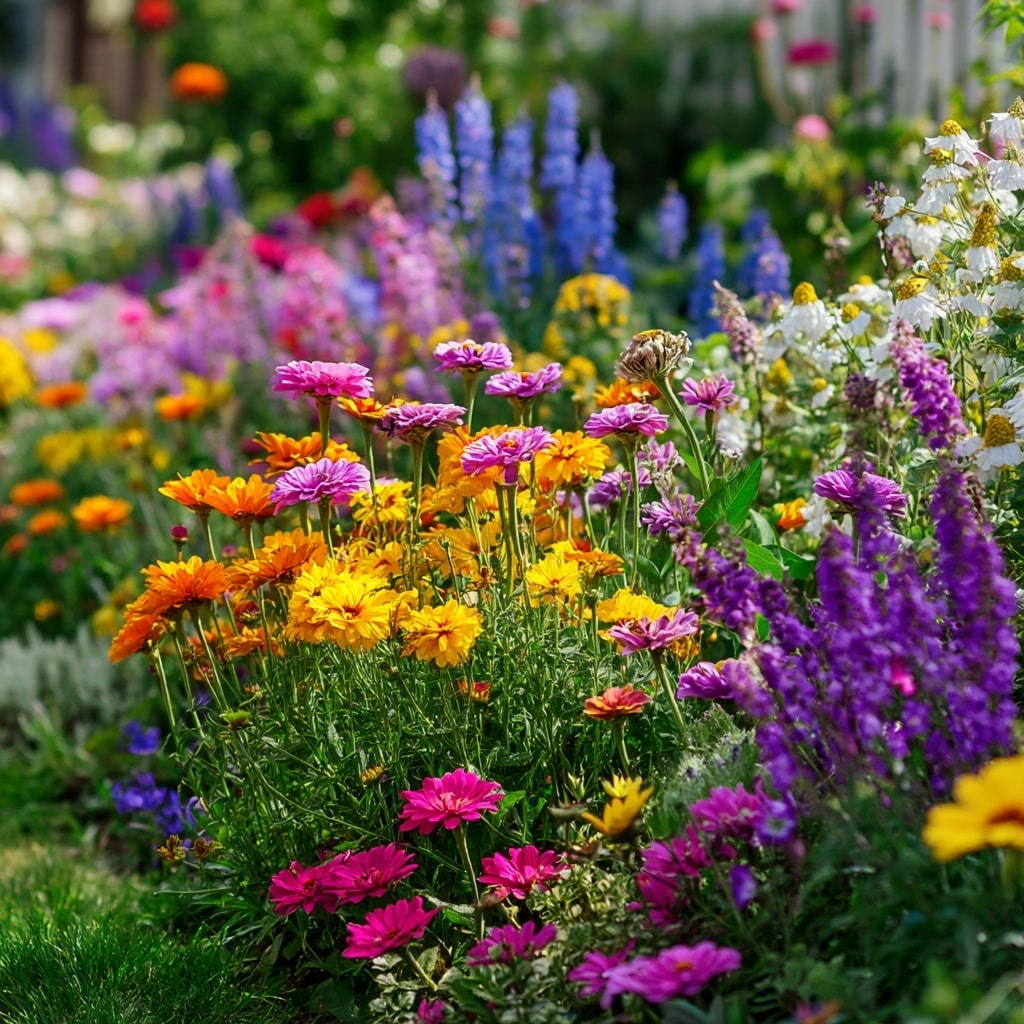
Once the foundation is set, it’s time to bring color and life to your flower beds in front of house with the right mix of plants. But before grabbing the brightest blooms, think strategically—your choices should suit your climate, maintenance level, and visual goals.
1. Match Flowers to Your Climate
Every plant has a comfort zone. To avoid constant replacements or plant shock, select flowers that are well-suited to your USDA Hardiness Zone. Visit a local nursery or garden center to discover:
- Native perennials that return each year
- Annuals that thrive in seasonal temperatures
- Drought-tolerant species for dry areas
For hot climates, consider lantana, zinnias, or black-eyed Susans. In cooler regions, daylilies, pansies, or columbine may do better.
2. Plan for Continuous Bloom
A front yard that blooms year-round keeps your home feeling fresh and lively. Mix plants with staggered bloom times to maintain constant color:
- Early-season: tulips, daffodils, pansies
- Mid-season: salvia, coneflowers, snapdragons
- Late-season: asters, mums, ornamental kale
This approach not only maintains curb appeal, but also supports pollinators throughout the year.
3. Think in Color Palettes, Not Chaos
While mixing colors can be fun, intentional palettes look more professional. Start with a dominant hue (e.g., purples), then add:
- A contrasting color (like yellow or white) to pop
- A neutral base (like green foliage or silver-leaved plants) to balance
Repeating colors in various spots across your flower beds in front of house helps unify the overall look.
4. Include Foliage, Not Just Flowers
Don’t rely solely on blooms. Foliage adds texture, structure, and year-round interest:
- Hostas or heucheras for shade
- Sedum or lamb’s ear for sun
- Ferns or grasses for movement and elegance
A strong foliage base supports the changing colors of seasonal flowers and keeps the bed looking full during off-bloom periods.
Smart flower selection ensures your beds look beautiful, are easier to maintain, and truly suit your space—not just for one season, but year after year.
Creating a Welcoming Entrance with Flower Beds
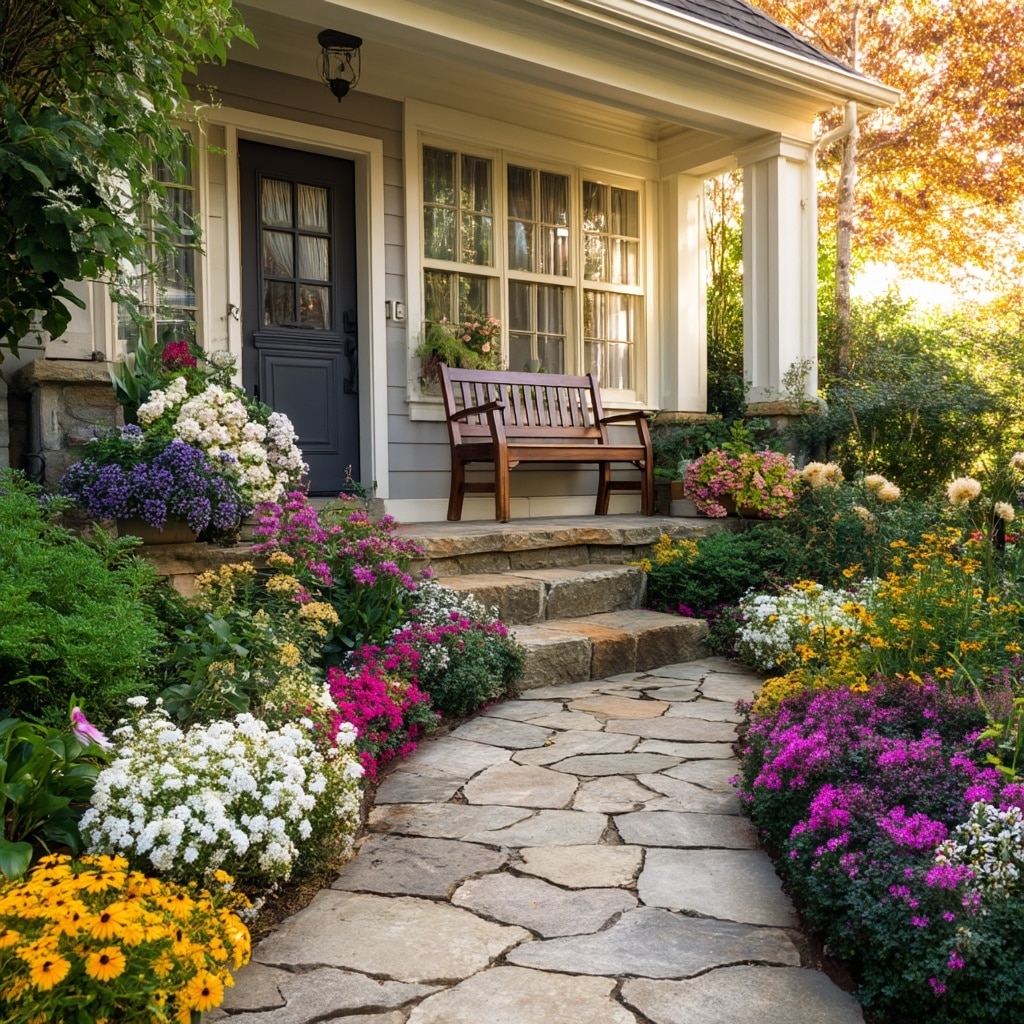
The front entrance of your home sets the tone for everything beyond the door. Thoughtfully designed flower beds in front of house not only beautify the space but also guide guests in and create a warm first impression. Whether you have a wide porch, a winding path, or just a small stoop, there are clever ways to make your entry feel inviting and full of personality.
1. Frame the Front Door
Create symmetry by placing tall flowering plants or shrubs on either side of your doorway. This anchors the space and naturally draws the eye to your front entrance. Try:
- Boxwoods or hydrangeas for structure
- Snapdragons or lupines for vertical color
- Trailing petunias or sweet potato vine in pots for added softness
Keep the base of the beds full with low-growing, seasonal color to finish the look.
2. Line the Pathway with Blooms
If you have a walkway, define it with flower beds or borders on each side. This creates a sense of direction and movement. Combine:
- Edging plants like alyssum, dwarf marigolds, or creeping thyme
- Medium-height flowers like salvia or echinacea for a lush middle layer
- Accent lighting to illuminate the beds at night and enhance curb appeal
The gentle rhythm of repeating flowers leads guests straight to your door with a touch of charm.
3. Add a Bench or Sitting Area
Even a small bench near your flower beds invites connection. It suggests your garden is not just for show—it’s a space to enjoy. Choose a bench that suits your home’s style (rustic wood, sleek metal, or vintage wrought iron), and soften the area with:
- Colorful pillows
- Potted plants
- A small side table for practicality
This cozy touch transforms your front yard into an extension of your living space.
4. Highlight with Lighting
Flower beds look stunning during the day—but don’t forget about the evening. Add solar-powered path lights, uplights beneath tall plants, or spotlights focused on feature beds. This creates depth, drama, and safety, while showcasing your plants even after sunset.
With a few design decisions, your flower beds in front of house can do more than look good—they can make your entire home feel more welcoming and lived in.
Flower Bed Ideas for Small Front Yards
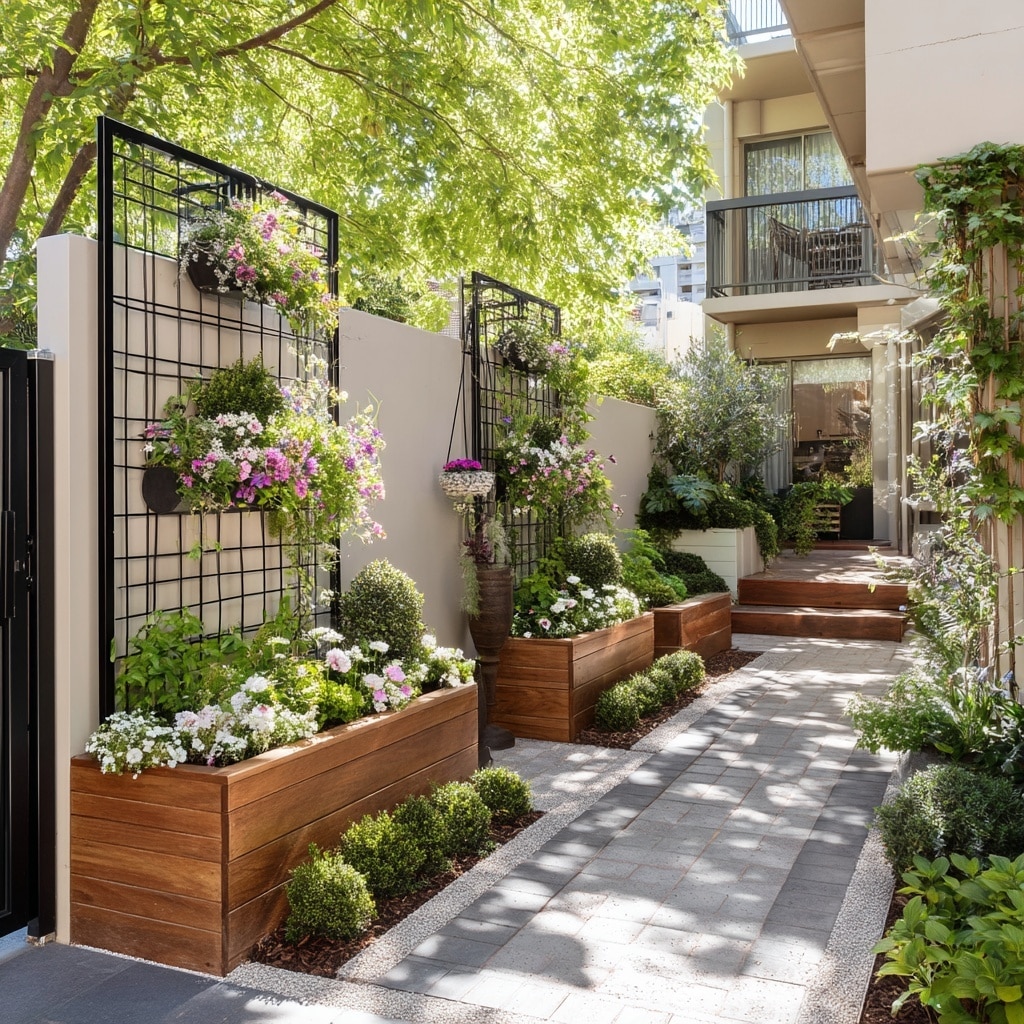
Limited space doesn’t have to limit creativity. Even the smallest front yard can host striking flower beds in front of house with the right design choices. The goal is to make every square foot feel intentional, layered, and vibrant—without overwhelming the space.
1. Go Vertical with Your Design
When ground space is scarce, think upward. Vertical gardening maximizes room and adds visual interest. Try:
- Trellises with climbing vines like clematis or morning glory
- Wall-mounted planters for herbs or small blooms
- Hanging baskets on porch overhangs or shepherd hooks
These not only conserve space but draw the eye upward, making the area feel larger.
2. Choose Compact or Dwarf Plants
Select varieties bred specifically for small gardens. Look for terms like “compact,” “dwarf,” or “patio” on plant tags. Ideal choices include:
- Dwarf coreopsis
- Miniature roses
- Compact lavender
- Salvia ‘Little Night’
Spacing is critical—leave enough room between plants to avoid crowding, which can reduce airflow and lead to disease.
- Stone or brick edging
- Decorative metal borders
- Low-growing border plants like dwarf mondo grass or creeping Jenny
Strong edges also prevent grass or mulch from spilling into walkways or driveways.
4. Keep the Color Palette Simple
Too many bold colors in a small space can feel chaotic. Stick with two to three main hues, repeating them throughout the bed for unity. Complement with neutral foliage to create contrast without clutter.
5. Use Containers to Flex and Expand
If you’re tight on planting space, containers are your best friend. They add height, mobility, and style. Use:
- Varying pot sizes and materials for texture
- One “thriller” (tall plant), “filler” (medium plant), and “spiller” (trailing plant) per pot
- Groupings of three for a professional look
A small front yard can pack a big punch when every plant is placed with purpose. Smart layering, clean lines, and vertical elements make even the tiniest garden feel lush and welcoming.
Flower Bed Ideas for Large Front Yards
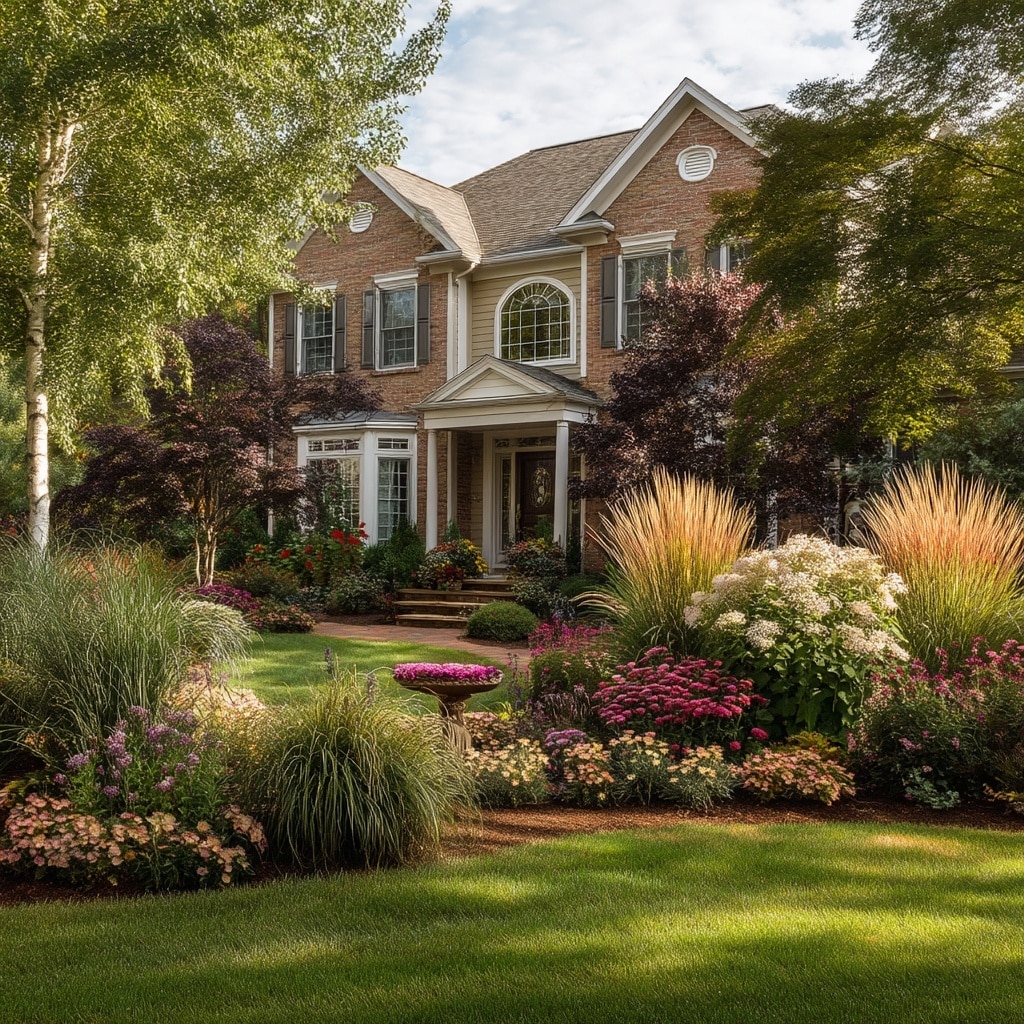
A spacious front yard offers room to dream big—but it also requires thoughtful planning to avoid feeling empty or scattered. When designing flower beds in front of house on a larger scale, the key is to create focal points, add structure, and use plant groupings that match the yard’s proportions.
1. Make a Bold Statement with Wide Beds
Broad, sweeping flower beds are a natural fit for expansive lawns. These beds can:
- Stretch along walkways, driveways, or the front of the house
- Follow natural curves in the landscape
- Be built around trees or hardscape features
Use a mix of perennials for long-term structure and annuals for seasonal bursts of color to keep things dynamic throughout the year.
2. Break Up the Space with Strategic Placement
Large yards can sometimes feel too open. Use flower beds to define zones and guide the eye:
- Frame the corners of your yard with anchor beds
- Use symmetrical designs near the home and natural curves further out
- Add island beds in open lawn areas to create dimension and flow
Groupings of three or five beds (in asymmetrical balance) often feel most natural in wide-open spaces.
3. Layer Heights for Depth and Drama
Use plant height strategically to avoid flat-looking beds. Layer from tallest to shortest:
- Back row: ornamental grasses, hollyhocks, sunflowers
- Middle row: coneflowers, salvia, yarrow
- Front row: begonias, petunias, sweet alyssum
Height variation also provides movement and seasonal interest—especially when taller plants sway in the breeze or bloom at different times.
4. Incorporate a Focal Point
A visual anchor can help organize the space. Try:
- A birdbath surrounded by pollinator plants
- A garden sculpture or large decorative pot
- A bench or arbor to create a rest area amid the blooms
Focal points add structure and give your garden a professional, cohesive look.
5. Mix Evergreen and Seasonal Plants
Keep your flower beds in front of house looking alive even in the off-season by incorporating evergreens:
- Boxwood
- Dwarf conifers
- Nandina or holly
These provide structure and color year-round, even when flowers fade.
Designing for a large front yard means balancing scale with structure. With wide beds, layered plants, and intentional focal points, your landscape can feel both expansive and thoughtfully curated.
Low-Maintenance Flower Bed Ideas
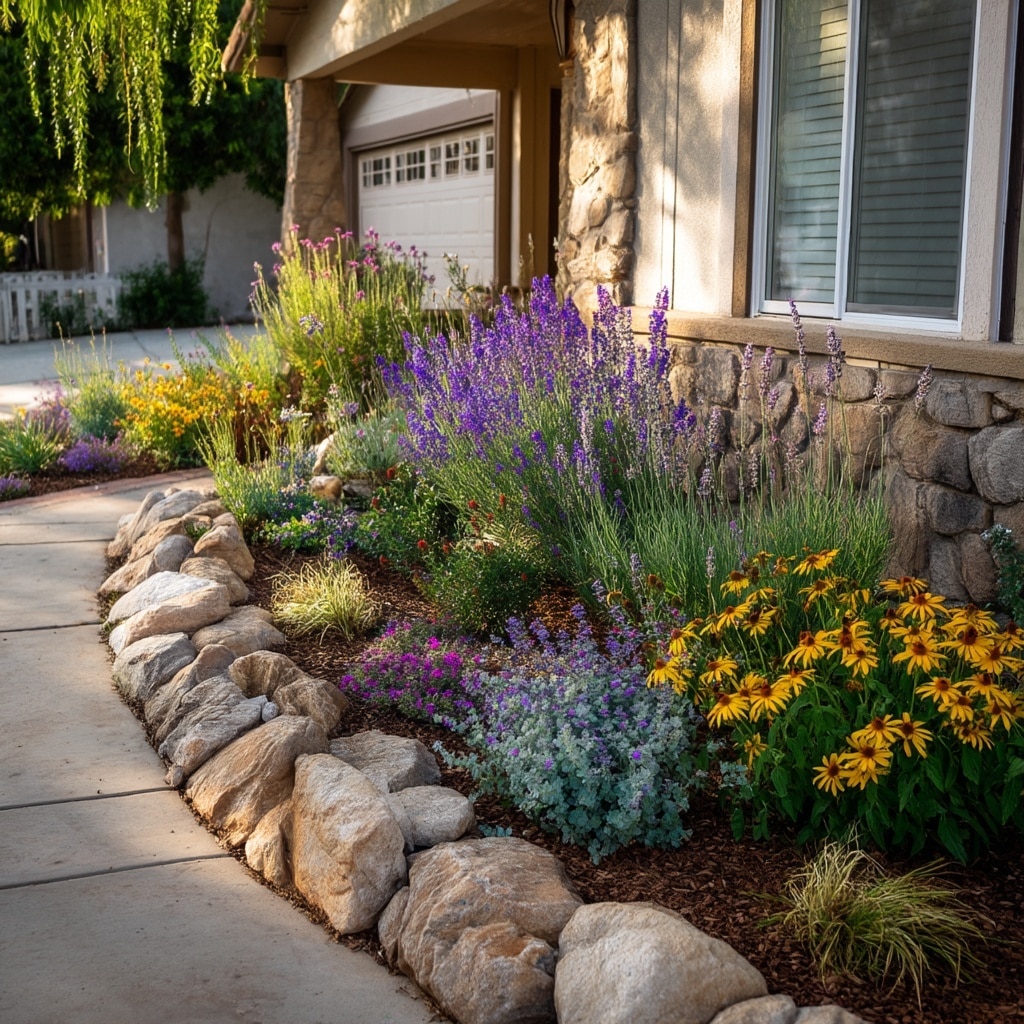
Creating beautiful flower beds in front of house doesn’t have to mean hours of upkeep every week. With the right plant selection and smart design choices, you can enjoy vibrant, inviting beds that thrive with minimal effort—perfect for busy homeowners or those new to gardening.
1. Choose Drought-Tolerant and Hardy Plants
One of the easiest ways to cut down on maintenance is to select plants that require less water and attention. Consider:
- Lavender
- Sedum
- Russian sage
- Black-eyed Susans
- Coneflowers
2. Use Mulch to Reduce Weeds and Watering
A 2–3 inch layer of mulch is a low-maintenance gardener’s best friend. It:
- Retains soil moisture
- Suppresses weed growth
- Regulates soil temperature
- Adds a finished, tidy look to beds
Choose natural mulch like shredded bark or composted leaves for best results. Reapply once or twice a year.
3. Incorporate Ground Covers
Ground cover plants create a living mulch that fills empty space, reduces weeds, and requires little effort. Good options include:
- Creeping thyme
- Ajuga
- Liriope
- Ice plant (in sunny, dry areas)
These low-growing plants spread over time and offer color, texture, or even blooms without the fuss.
4. Minimize Seasonal Replanting
Perennials are ideal for low-maintenance flower beds. They return each year with little intervention. Consider mixing in a few self-seeding annuals like cosmos or California poppies, which reappear with minimal effort.
Also, limit the number of plant varieties in each bed. Fewer types = easier care and less pruning or deadheading.
5. Add Decorative Elements that Don’t Need Water
Balance your living plants with features that enhance beauty but require no upkeep:
- Garden sculptures or stone accents
- Decorative gravel or river rocks
- Ceramic pots with succulents or faux plants
- A dry creek bed or rock garden
These elements break up large beds, add visual interest, and reduce overall planting area—saving water and time.
✅ Conclusion
Designing beautiful flower beds in front of house is one of the most rewarding ways to boost curb appeal and bring color to your everyday life. Whether you have a small urban patch or a sprawling front yard, thoughtful planning goes a long way. Focus on the fundamentals—sunlight, soil, plant selection, and structure—and build from there.
You don’t need to be a master gardener to create a landscape that feels welcoming, personal, and low-maintenance. Just start with one bed, one bloom, and one step at a time—and soon, your front yard will be a space you love to come home to.

